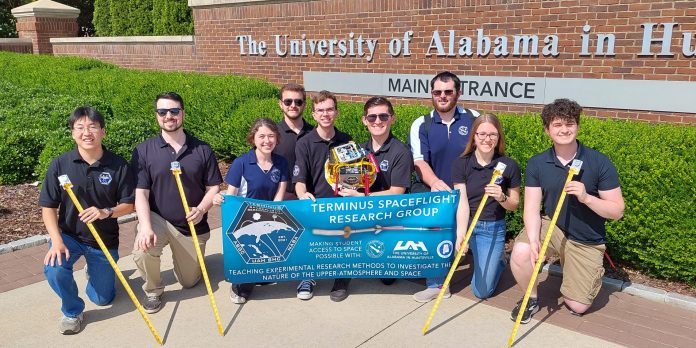HUNTSVILLE – In a couple of weeks, a student team at the University of Alabama in Huntsville is set to launch its biggest payload yet into the upper atmosphere from the NASA Wallops Flight Facility on Wallops Island, Va.
The launch is part of NASA’s RockSat Program, an initiative that aims to connect higher education students from across the United States with opportunities to fly their experiments into space on NASA sounding rockets. The 2024 event will mark the second launch in three years for the UAH TERMINUS (Teaching Experimental Research Methods to Investigate the Nature of the Upper-atmosphere and Space) Spaceflight Research Group, and will be the smallest satellite tether release ever attempted in space.

that seeks to reduce the cost and complexity of future TERMINUS payloads by being
reusable and modular, and a special satellite deployment experiment named SwingSat. (Courtesy UAH Space Hardware Club)
TSRG is a subset of the UAH Space Hardware Club, UAH’s largest student group, boasting nearly 300 members. Their latest mission has been supported by roughly 90 students over two years since starting development in 2022. The group’s goal is to enable students to interact with NASA personnel in every step of spacecraft development, not only building the crafts themselves, but also traveling to a NASA facility and participating in activities such as payload integration, testing, vehicle assembly, launch, recovery and other spaceport activities.
The group was founded in 2021 by Ben Campbell, a 2024 doctoral student in aerospace systems engineering, who previously worked on three CubeSat missions and two sounding rocket missions. Campbell envisioned empowering students to join in the development and flight of new spacecraft.
“I came to UAH in 2021 as a grad student and heard about the UAH Space Hardware Club,” Campbell said. “We started TERMINUS in the fall of 2021 and got plugged in with NASA’s RockSat Program.”
NASA RockSat is an initiative that features successive levels of student payload flights, from RockOn where TERMINUS saw its first payload launched in June 2022, to RockSat-C, and finally the pinnacle of the program, RockSat-X.
“RockSat-X is the biggest,” Campbell said in noting the status of the August launch. “You choose your own experiments, and it’s fully up to the group to decide whatever it wants to make for a spacecraft. We had people come up with a variety of different ideas at UAH and put them to a vote.”
The payload will be a suborbital technology demonstration mission named ADRASTEA for “Augmented Deployment and Release of Artificial Satellites by Tether Extension and Acceleration.” The UAH spacecraft includes two primary systems: a spacecraft bus called JUPITER, short for “Joint Union of Payload Information and Technology between Experiments and Rockets,” that seeks to reduce the cost and complexity of future TERMINUS payloads by being reusable and modular, and a special satellite deployment experiment called SwingSat.
With SwingSat, the group hopes to demonstrate an alternative method of deploying satellites by utilizing four devices called momentum exchange tethers (METs) at SmallSat-scale, a concept conceived by Campbell that is also the subject of his Ph.D. dissertation research, supported by a UAH Alabama Space Grant Consortium fellowship. The system will employ a centrifugal release system to dispense multiple satellites without propellant, rather than waiting for propulsion system burns to be completed using complex hardware.
“The altitude range is 150-170 kilometers,” Campbell said, a height well beyond the Karman line, which is the boundary of space, or about 100 kilometers above sea level. “We’ll be active for about 13-15 minutes. After the launch, the outer skirt of the rocket will separate, then over the next 30 seconds or so the CubeSat will unspool the tethers to go through some extension, rotation and release maneuvers.
“It’s kind of like the idea of a shepherd’s sling, like David used to defeat Goliath, except slinging satellites instead of stones. The whole reason this is being investigated is that traditionally, you need some sort of thruster to get anywhere far in space. CubeSats are small, so it’s hard to add in conventional thrusters. This is an alternative way to deploy them using basic rotating motion, simply ‘throwing’ the thing.”
The team is developing future projects that include other alternative space propulsion methods, atmospheric re-entry durability, custom attitude determination and control systems, biological effects on microorganisms and plant matter exposed to space, and 3D-printing in space. Possible missions to low Earth orbit and to the lunar surface are also being discussed.
“Our payload will pull around 30gs during launch, so everything has to be pretty rock solid, Campbell said. “We had to design all this hardware so it can be fully exposed to space and have to deal with thermal effects. In the end it splashes down in the ocean, so you have to make it waterproof too. Hopefully it will still survive so that you don’t get water seeping in to mess with the electronics.
“We are going to be working side-by-side with NASA personnel on the preflight checklist, basically as close as you can get without being a direct NASA employee or contractor. Some of the last fingerprints to touch the spacecraft until the day when it launches from the pad will be ours.”
Don’t miss out! Subscribe to our email newsletter to have all our smart stories delivered to your inbox.



